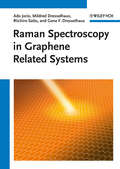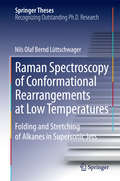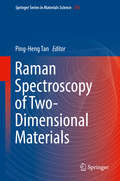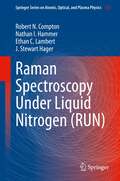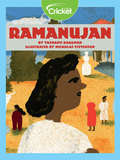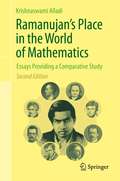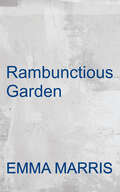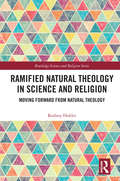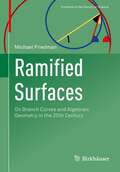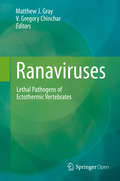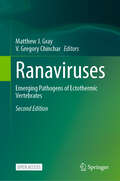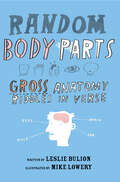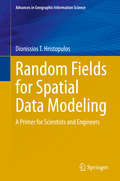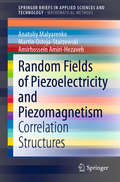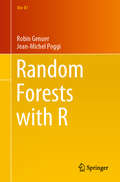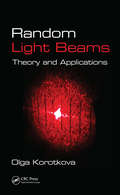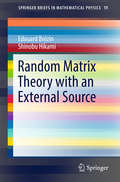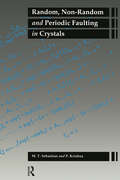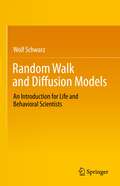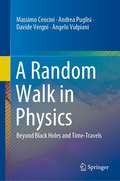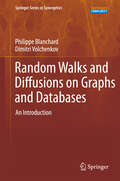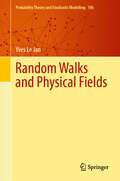- Table View
- List View
Raman Spectroscopy in Graphene Related Systems
by Mildred S. Dresselhaus Gene Dresselhaus Riichiro Saito Ado JorioRaman spectroscopy is the inelastic scattering of light by matter. Being highly sensitive to the physical and chemical properties of materials, as well as to environmental effects that change these properties, Raman spectroscopy is now evolving into one of the most important tools for nanoscience and nanotechnology.<P><P> In contrast to usual microscopyrelated techniques, the advantages of using light for nanoscience relate toboth experimental and fundamental aspects.
Raman Spectroscopy of Conformational Rearrangements at Low Temperatures
by Nils Olaf Bernd LüttschwagerThis thesis identifies the turning point in chain length, after which alkanes self-solvate into a folded structure instead of an extended stretched conformation. After this turning point, London dispersion forces rearrange isolated n-alkanes into a particular hairpin-structure, while for shorter chain lengths, a simple stretched conformation is energetically preferred. This thesis can locate the experimental turning point for the first time in an interaction-free manner from measurements of unbranched alkanes at low temperatures in supersonic jet expansions. It contains a detailed analysis of the vibrational Raman spectra of the chain molecules, which is supported by comprehensive quantum chemical simulations. In this way, the detailed balance between inter-chain attraction and conformational flexibility can be quantified. The investigations are complemented by measurements of perfluoroalkanes and similarities and differences between the compounds are discussed. Furthermore, Nils Lüttschwager determines the stiffnesses (elastic moduli) of two of the most common industrial polymers: polyethylene and polytetrafluorethylene. He uses in this thesis a sophisticated extrapolation to calculate this value from quantities of their building blocks, showing that the single polymer molecules can be as stiff as a rod of steel.
Raman Spectroscopy of Two-Dimensional Materials (Springer Series in Materials Science #276)
by Ping-Heng TanThis book shows the electronic, optical and lattice-vibration properties of the two-dimensional materials which are revealed by the Raman spectroscopy. It consists of eleven chapters covering various Raman spectroscopy techniques (ultralow-frequency, resonant Raman spectroscopy, Raman imaging), different kinds of two-dimensional materials (in-plane isotropy and anisotropy materials, van der Waals heterostructures) and their physical properties (double-resonant theory, surface and interface effect). The topics include the theory origin, experimental phenomenon and advanced techniques in this area. This book is interesting and useful to a wide readership in various fields of condensed matter physics, materials science and engineering.
Raman Spectroscopy Under Liquid Nitrogen (Springer Series on Atomic, Optical, and Plasma Physics #121)
by Robert N. Compton Nathan I. Hammer Ethan C. Lambert J. Stewart HagerThis book describes a simple yet innovative method for performing Raman spectroscopy of samples submerged under liquid nitrogen. While Raman spectroscopy has proven to be a powerful tool for the characterization of the structure of matter in the gaseous, liquid, and solid phases, one major difficulty in its application has been laser damage to the material under investigation, especially for biological samples. This book demonstrates how immersion of the sample in liquid nitrogen protects the sample from thermal degradation and oxidation at high incident laser power and allows improvements in sensitivity and spectral resolution over room-temperature Raman spectroscopy, leading to the so-called RUN (Raman Spectroscopy Under liquid Nitrogen) technique. Cooling to liquid nitrogen temperature also allows the selection of the lowest energy molecular conformation for molecules which may have many low energy conformers. In addition, the presence of liquid nitrogen over a roughened surface improves the sensitivity of Surface Enhanced Raman Spectroscopy (SERS), enabling the closely related SERSUN (Surface-Enhanced Raman Spectroscopy Under liquid Nitrogen) technique. This book starts with the theoretical and experimental basics of Raman and polarized Raman spectroscopy, before moving on to detailed descriptions of RUN and SERSUN. Room temperature and RUN spectra are provided for over fifty molecules.
Ramanujan
by Vashanti RahamanSrinivasa Ramanujan has been described as a rock-star mathematician. Though he died almost one hundred years ago, his work in mathematics will always be important.
Ramanujan's Place in the World of Mathematics: Essays Providing a Comparative Study
by Krishnaswami AlladiThe First Edition of the book is a collection of articles, all by the author, on the Indian mathematical genius Srinivasa Ramanujan as well as on some of the greatest mathematicians in history whose life and works have things in common with Ramanujan. It presents a unique comparative study of Ramanujan’s spectacular discoveries and remarkable life with the monumental contributions of various mathematical luminaries, some of whom, like Ramanujan, overcame great difficulties in life. Also, among the articles are reviews of three important books on Ramanujan’s mathematics and life. In addition, some aspects of Ramanujan’s contributions, such as his remarkable formulae for the number pi, his path-breaking work in the theory of partitions, and his fundamental observations on quadratic forms, are discussed. Finally, the book describes various current efforts to ensure that the legacy of Ramanujan will be preserved and continue to thrive in the future.This Second Edition is an expanded version of the first with six more articles by the author. Of note is the inclusion of a detailed review of the movie The Man Who Knew Infinity, a description of the fundamental work of the SASTRA Ramanujan Prize Winners, and an account of the Royal Society Conference to honour Ramanujan’s legacy on the centenary of his election as FRS.
Rambunctious Garden: Saving Nature in a Post-Wild World
by Emma MarrisA paradigm shift is roiling the environmental world. For decades people have unquestioningly accepted the idea that our goal is to preserve nature in its pristine, pre-human state. But many scientists have come to see this as an outdated dream that thwarts bold new plans to save the environment and prevents us from having a fuller relationship with nature. Humans have changed the landscapes they inhabit since prehistory, and climate change means even the remotest places now bear the fingerprints of humanity. Emma Marris argues convincingly that it is time to look forward and create the "rambunctious garden," a hybrid of wild nature and human management.
Ramified Natural Theology in Science and Religion: Moving Forward from Natural Theology (Routledge Science and Religion Series)
by Rodney HolderThis book offers a rationale for a new ‘ramified natural theology’ that is in dialogue with both science and historical-critical study of the Bible. Traditionally, knowledge of God has been seen to come from two sources, nature and revelation. However, a rigid separation between these sources cannot be maintained, since what purports to be revelation cannot be accepted without qualification: rational argument is needed to infer both the existence of God from nature and the particular truth claims of the Christian faith from the Bible. Hence the distinction between ‘bare natural theology’ and ‘ramified natural theology.’ The book begins with bare natural theology as background to its main focus on ramified natural theology. Bayesian confirmation theory is utilised to evaluate competing hypotheses in both cases, in a similar manner to that by which competing hypotheses in science can be evaluated on the basis of empirical data. In this way a case is built up for the rationality of a Christian theist worldview. Addressing issues of science, theology and revelation in a new framework, this book will be of keen interest to scholars working in Religion and Science, Natural Theology, Philosophy of Religion, Biblical Studies, Systematic Theology, and Science and Culture.
Ramified Surfaces: On Branch Curves and Algebraic Geometry in the 20th Century (Frontiers in the History of Science)
by Michael FriedmanThe book offers an extensive study on the convoluted history of the research of algebraic surfaces, focusing for the first time on one of its characterizing curves: the branch curve. Starting with separate beginnings during the 19th century with descriptive geometry as well as knot theory, the book focuses on the 20th century, covering the rise of the Italian school of algebraic geometry between the 1900s till the 1930s (with Federigo Enriques, Oscar Zariski and Beniamino Segre, among others), the decline of its classical approach during the 1940s and the 1950s (with Oscar Chisini and his students), and the emergence of new approaches with Boris Moishezon’s program of braid monodromy factorization.By focusing on how the research on one specific curve changed during the 20th century, the author provides insights concerning the dynamics of epistemic objects and configurations of mathematical research. It is in this sense that the book offers to take the branch curve as a cross-section through the history of algebraic geometry of the 20th century, considering this curve as an intersection of several research approaches and methods. Researchers in the history of science and of mathematics as well as mathematicians will certainly find this book interesting and appealing, contributing to the growing research on the history of algebraic geometry and its changing images.
Ramsar Wetlands of the North American West Coast and Central Pacific: An Atlas
by Ricardo D. LopezThis is the first comprehensive international atlas featuring all ecological services provided by Ramsar wetlands, with complete views of all Ramsar sites, through remote sensing and mapping. Written by an international expert on wetlands and remote sensing, this atlas is for a broad audience and compiles much-needed information on how the Ramsar wetlands are of significant value to the planet and society and can and should be managed in such a way that supports planetary sustainability. Focused on the 72 designated Ramsar sites along the western coasts of Alaska, Canada, California, Mexico, and the Central Pacific islands, each wetland is articulately documented with respect to its specific ecological functions and services.FEATURES Provides a comprehensive assessment of the key biophysical and societal elements of each Ramsar-designated wetland along the North American West Coast and Central Pacific Brings all designated Ramsar wetlands to the reader in one visually appealing compendium using geospatial technology Aids in highlighting the importance of and options for wetland conservation and restoration worldwide Explains the important role that wetlands play in environmental sustainability, directly supporting the global sustainable development goals of the United Nations Introduces the contributions of the Ramsar Convention on Wetlands to global conservation and restoration This atlas is intended for wetland managers and policymakers involved in the Ramsar Convention activities and for wetland ecologists and other allied environmental scientists and practitioners, such as hydrologists, microbiologists, and botanists. It is also a valuable resource for researchers, faculty, and graduate students affiliated with programs such as wetland ecology, wetland management, environmental studies, environmental management, and survey of wetlands.
Ranaviruses
by Matthew J. Gray V. Gregory ChincharThis is the first book on ranaviruses. Ranaviruses are double-stranded DNA viruses that cause hemorrhagic disease in amphibians, reptiles, and fish. They have caused mass die-offs of ectothermic vertebrates in wild and captive populations around the globe. There is evidence that this pathogen is emerging and responsible for population declines in certain locations. Considering that amphibians and freshwater turtles are suitable hosts and the most imperiled vertebrate taxa in the world, ranaviruses can have significant impacts on biodiversity and ecosystem function. Additionally, many fish that are raised in aquaculture facilities and traded internationally are suitable hosts; thus, the potential economic impact of ranaviruses is significant. Ranaviruses also serve as a model for replication and gene function of large double-stranded DNA viruses. There is an urgent need to assemble the contemporary information on ranaviruses and provide guidance on how to assess their threats in populations. Through the Global Ranavirus Consortium, 24 experts from six countries were organize to write this volume, the first book on ranaviruses. The book begins with a discussion on the global extent of ranaviruses, case histories of infection and disease in ectothermic vertebrates, and current phylogeny. Basic principles of ranavirus ecology and evolution are covered next, with a focus on host-pathogen interactions and how the virus emerges in its environment. There are two chapters that will discuss the molecular biology of ranaviruses, host response to infection, and the genes responsible for immune system evasion. One chapter establishes standards for testing for infection and diagnosing ranaviral disease. The book ends by providing guidance on how to design ranavirus surveillance studies and analyze data to determine risk, and discussing the role of the Global Ranavirus Consortium in organizing research and outreach activities.
Ranaviruses: Emerging Pathogens of Ectothermic Vertebrates
by Matthew J. Gray V. Gregory ChincharThis is a open access book. Ranaviruses, double-stranded DNA viruses (family Iridoviridae) that cause systemic, life-threatening disease in a variety of amphibians, reptiles and fish, have contributed to mass die-offs of both wild and captive populations around the globe. These viruses are emerging and increasingly responsible for population declines of ectothermic vertebrates. Because amphibians, reptiles, and freshwater turtles are suitable hosts and among the most imperiled vertebrate taxa in the world, ranaviruses can have significant impacts on biodiversity and ecosystem function. Additionally, many fish that are raised in aquaculture facilities and traded internationally are suitable hosts; thus, the potential economic impact of ranaviruses is significant. Ranaviruses also serve as a model for understanding viral replication and gene function among large double-stranded DNA viruses, e.g., poxviruses, asfarvirus, and ascoviruses. Lastly, study of the host immune response to ranaviral disease and the identification of viral immune evasion genes that negatively regulate host immune functions provide insight into which specific immune elements are most important in protecting host species against severe disease. The effort to produce a 2nd edition of our earlier work grew out of a recent meeting (1st Global Amphibian and Reptile Disease Conference) held in August 2022. Given the continued research in ranaviruses and ranaviral disease since the first edition, this new book updates the latest information on ranaviruses and provides guidance on how to monitor and manage ranaviruses in cold-blooded vertebrate populations.
The RAND Corporation (1989—2009)
by Jean-Loup SamaanBased on a case study of the RAND Corporation, this shows how the uncertainties of US defense policies since the fall of the USSR can be understood and illustrated through an analysis of the evolution of the think tank community, and more particularly through a sociological study of the so-called defense intellectuals such as the RAND Corporation.
Random Acts of Kindness by Animals: Inspiring True Tales of Animal Love
by Stephanie LaLandHeartwarming and Compassionate Stories of Animal Love"This book is a loving tribute to all creatures, great and small." ?Tippi HedrenFilled with fascinating and heartwarming stories, this book details the power of animal love. Good deeds can be done by more than just humans!True tales of kindness. Random Acts of Kindness by Animals is packed with captivating stories, big and small, from simple acts of kindness, to grand gestures of compassion performed by various animals. Author and known speaker on animal-related issues, Stephanie LaLand has gathered a multitude of stories sure to fill your heart with happiness and hope. From dogs to dolphins, learn true stories of animal love, devotion, and bravery.Proof that human kindness is shared with animals. Anyone who’s had a pet knows there is something special about them. We see it in their eyes when they look at us affectionately or play with others or help someone in need. Animal behavior is interesting because in many ways, how they act and the things they do are similar to the way we care for each other. Animals are affectionate and smart creatures, and this book illustrates why kindness matters for us all.Inside, you’ll find:Inspiring animal stories of true animal love that will surprise you Examples of kindness and good deeds performed by our beloved animalsAnimal stories for adults and animal stories for children to teach instinctive behavioral connections between humans and animalsIf you liked Pawverbs for a Dog Lover’s Heart, You've Goat This, or Dogwinks, you’ll love Random Acts of Kindness by Animals.
Random Body Parts: Gross Anatomy Riddles in Verse
by Leslie BulionHumorous, Shakespearean-inspired verse about body parts blends with whimsical art in this award-winning science poetry collection from Leslie Bulion.Leslie Bulion's award-winning volume of anatomical verse begins with an invitation to solve a series of poetic riddles: "Of course you have a body, / But do you have a clue / Where all the body parts you've got are found / And what they do?"Each poem that follows poses a puzzle in verse (with a sly wink and a nod to Shakespeare) and provides hints for uncovering the body part in question—from blood, bones, eyes, and the heart to the brain, pancreas, stomach, tongue, and more.Sidebars throughout offer additional facts, while appended notes offer a crash course on poetic form and a few facts about the Shakespearean works that inspired the verses. Mike Lowery's playful, original art adds context along with photographs and a diagram of the human body. A truly unique nonfiction title that's ideal for cross-curricular learning!
Random Fields for Spatial Data Modeling: A Primer for Scientists and Engineers (Advances in Geographic Information Science)
by Dionissios T. HristopulosThis book provides an inter-disciplinary introduction to the theory of random fields and its applications. Spatial models and spatial data analysis are integral parts of many scientific and engineering disciplines. Random fields provide a general theoretical framework for the development of spatial models and their applications in data analysis. The contents of the book include topics from classical statistics and random field theory (regression models, Gaussian random fields, stationarity, correlation functions) spatial statistics (variogram estimation, model inference, kriging-based prediction) and statistical physics (fractals, Ising model, simulated annealing, maximum entropy, functional integral representations, perturbation and variational methods). The book also explores links between random fields, Gaussian processes and neural networks used in machine learning. Connections with applied mathematics are highlighted by means of models based on stochastic partial differential equations. An interlude on autoregressive time series provides useful lower-dimensional analogies and a connection with the classical linear harmonic oscillator. Other chapters focus on non-Gaussian random fields and stochastic simulation methods. The book also presents results based on the author’s research on Spartan random fields that were inspired by statistical field theories originating in physics. The equivalence of the one-dimensional Spartan random field model with the classical, linear, damped harmonic oscillator driven by white noise is highlighted. Ideas with potentially significant computational gains for the processing of big spatial data are presented and discussed. The final chapter concludes with a description of the Karhunen-Loève expansion of the Spartan model. The book will appeal to engineers, physicists, and geoscientists whose research involves spatial models or spatial data analysis. Anyone with background in probability and statistics can read at least parts of the book. Some chapters will be easier to understand by readers familiar with differential equations and Fourier transforms.
Random Fields of Piezoelectricity and Piezomagnetism: Correlation Structures (SpringerBriefs in Applied Sciences and Technology)
by Anatoliy Malyarenko Martin Ostoja-Starzewski Amirhossein Amiri-HezavehRandom fields are a necessity when formulating stochastic continuum theories. In this book, a theory of random piezoelectric and piezomagnetic materials is developed. First, elements of the continuum mechanics of electromagnetic solids are presented. Then the relevant linear governing equations are introduced, written in terms of either a displacement approach or a stress approach, along with linear variational principles. On this basis, a statistical description of second-order (statistically) homogeneous and isotropic rank-3 tensor-valued random fields is given. With a group-theoretic foundation, correlation functions and their spectral counterparts are obtained in terms of stochastic integrals with respect to certain random measures for the fields that belong to orthotropic, tetragonal, and cubic crystal systems. The target audience will primarily comprise researchers and graduate students in theoretical mechanics, statistical physics, and probability.
Random Forests with R (Use R!)
by Robin Genuer Jean-Michel PoggiThis book offers an application-oriented guide to random forests: a statistical learning method extensively used in many fields of application, thanks to its excellent predictive performance, but also to its flexibility, which places few restrictions on the nature of the data used. Indeed, random forests can be adapted to both supervised classification problems and regression problems. In addition, they allow us to consider qualitative and quantitative explanatory variables together, without pre-processing. Moreover, they can be used to process standard data for which the number of observations is higher than the number of variables, while also performing very well in the high dimensional case, where the number of variables is quite large in comparison to the number of observations. Consequently, they are now among the preferred methods in the toolbox of statisticians and data scientists. The book is primarily intended for students in academic fields such as statistical education, but also for practitioners in statistics and machine learning. A scientific undergraduate degree is quite sufficient to take full advantage of the concepts, methods, and tools discussed. In terms of computer science skills, little background knowledge is required, though an introduction to the R language is recommended. Random forests are part of the family of tree-based methods; accordingly, after an introductory chapter, Chapter 2 presents CART trees. The next three chapters are devoted to random forests. They focus on their presentation (Chapter 3), on the variable importance tool (Chapter 4), and on the variable selection problem (Chapter 5), respectively. After discussing the concepts and methods, we illustrate their implementation on a running example. Then, various complements are provided before examining additional examples. Throughout the book, each result is given together with the code (in R) that can be used to reproduce it. Thus, the book offers readers essential information and concepts, together with examples and the software tools needed to analyse data using random forests.
Random Light Beams: Theory and Applications
by Olga KorotkovaRandom Light Beams: Theory and Applications contemplates the potential in harnessing random light. This book discusses light matter interactions, and concentrates on the various phenomena associated with beam-like fields. It explores natural and man-made light fields and gives an overview of recently introduced families of random light beams. It outlines mathematical tools for analysis, suggests schemes for realization, and discusses possible applications. The book introduces the essential concepts needed for a deeper understanding of the subject, discusses various classes of deterministic paraxial beams and examines random scalar beams. It highlights electromagnetic random beams and matters relating to generation, propagation in free space and various media, and discusses transmission through optical systems. It includes applications that benefit from the use of random beams, as well as the interaction of beams with deterministic optical systems.• Includes detailed mathematical description of different model sources and beams• Explores a wide range of man-made and natural media for beam interaction • Contains more than 100 illustrations on beam behavior• Offers information that is based on the scientific results of the last several years • Points to general methods for dealing with random beams, on the basis of which the readers can do independent researchIt gives examples of light propagation through the human eye, laser resonators, and negative phase materials. It discusses in detail propagation of random beams in random media, the scattering of random beams from collections of scatterers and thin random layers as well as the possible uses for these beams in imaging, tomography, and smart illumination.
Random Matrix Theory with an External Source
by Edouard Brézin Shinobu HikamiThis is a first book to show that the theory of the Gaussian random matrix is essential to understand the universal correlations with random fluctuations and to demonstrate that it is useful to evaluate topological universal quantities. We consider Gaussian random matrix models in the presence of a deterministic matrix source. In such models the correlation functions are known exactly for an arbitrary source and for any size of the matrices. The freedom given by the external source allows for various tunings to different classes of universality. The main interest is to use this freedom to compute various topological invariants for surfaces such as the intersection numbers for curves drawn on a surface of given genus with marked points, Euler characteristics, and the Gromov-Witten invariants. A remarkable duality for the average of characteristic polynomials is essential for obtaining such topological invariants. The analysis is extended to nonorientable surfaces and to surfaces with boundaries.
Random Non-Random Periodic Fau
by M. T. Sebastian P. KrishnaThis book provides a comprehensive overview of stacking faults in crystal structures. Subjects covered include: notations used in representations of close-packed structures; types of faults; methods of detection and measurement such as X-ray diffraction, electron diffraction and other techniques; theoretical models of non-random faulting during phase transitions; specific examples of - close packed structures including, zinc sulphide, silicon carbide and silver iodide.
Random Walk and Diffusion Models: An Introduction for Life and Behavioral Scientists
by Wolf SchwarzThis book offers an accessible introduction to random walk and diffusion models at a level consistent with the typical background of students in the life sciences. In recent decades these models have become widely used in areas far beyond their traditional origins in physics, for example, in studies of animal behavior, ecology, sociology, sports science, population genetics, public health applications, and human decision making. Developing the main formal concepts, the book provides detailed and intuitive step-by-step explanations, and moves smoothly from simple to more complex models. Finally, in the last chapter, some successful and original applications of random walk and diffusion models in the life and behavioral sciences are illustrated in detail. The treatment of basic techniques and models is consolidated and extended throughout by a set of carefully chosen exercises.
A Random Walk in Physics: Beyond Black Holes and Time-Travels
by Massimo Cencini Andrea Puglisi Davide Vergni Angelo VulpianiThis book offers an informal, easy-to-understand account of topics in modern physics and mathematics. The focus is, in particular, on statistical mechanics, soft matter, probability, chaos, complexity, and models, as well as their interplay. The book features 28 key entries and it is carefully structured so as to allow readers to pursue different paths that reflect their interests and priorities, thereby avoiding an excessively systematic presentation that might stifle interest. While the majority of the entries concern specific topics and arguments, some relate to important protagonists of science, highlighting and explaining their contributions. Advanced mathematics is avoided, and formulas are introduced in only a few cases. The book is a user-friendly tool that nevertheless avoids scientific compromise. It is of interest to all who seek a better grasp of the world that surrounds us and of the ideas that have changed our perceptions.
Random Walks and Diffusions on Graphs and Databases
by Philipp Blanchard Dimitri VolchenkovMost networks and databases that humans have to deal with contain large, albeit finite number of units. Their structure, for maintaining functional consistency of the components, is essentially not random and calls for a precise quantitative description of relations between nodes (or data units) and all network components. This book is an introduction, for both graduate students and newcomers to the field, to the theory of graphs and random walks on such graphs. The methods based on random walks and diffusions for exploring the structure of finite connected graphs and databases are reviewed (Markov chain analysis). This provides the necessary basis for consistently discussing a number of applications such diverse as electric resistance networks, estimation of land prices, urban planning, linguistic databases, music, and gene expression regulatory networks.
Random Walks and Physical Fields (Probability Theory and Stochastic Modelling #106)
by Yves Le JanThis book presents fundamental relations between random walks on graphs and field theories of mathematical physics. Such relations have been explored for several decades and remain a rapidly developing research area in probability theory.The main objects of study include Markov loops, spanning forests, random holonomies, and covers, and the purpose of the book is to investigate their relations to Bose fields, Fermi fields, and gauge fields. The book starts with a review of some basic notions of Markovian potential theory in the simple context of a finite or countable graph, followed by several chapters dedicated to the study of loop ensembles and related statistical physical models. Then, spanning trees and Fermi fields are introduced and related to loop ensembles. Next, the focus turns to topological properties of loops and graphs, with the introduction of connections on a graph, loop holonomies, and Yang–Mills measure. Among the main results presented is an intertwining relation between merge-and-split generators on loop ensembles and Casimir operators on connections, and the key reflection positivity property for the fields under consideration.Aimed at researchers and graduate students in probability and mathematical physics, this concise monograph is essentially self-contained. Familiarity with basic notions of probability, Poisson point processes, and discrete Markov chains are assumed of the reader.
